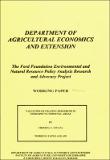| dc.contributor.author | Gwata, Chiedza C. | |
| dc.coverage.spatial | Zimbabwe. | en |
| dc.date.accessioned | 2015-08-04T13:20:21Z | |
| dc.date.available | 2015-08-04T13:20:21Z | |
| dc.date.issued | 1999-09 | |
| dc.identifier.citation | Gwata, C.C. (1979) Valuation of Grazing Resources in Zimbabwe's communal areas. AEE Working Paper no. 6/ 99. UZ, Mt. Pleasant, Harare : DAEE. | en |
| dc.identifier.uri | https://opendocs.ids.ac.uk/opendocs/handle/20.500.12413/6665 | |
| dc.description | A valuation of grazing lands in Zimbabwe's rural areas. | en |
| dc.description.abstract | the other three communal areas; Mhondoro-Ngezi, Chiduku and Buhera.
Households in natural region II have the highest mean MWTP for grazing compared to those households n natural regions III and IV.
Households under the traditional regime have the highest mean MWTP for grazing compared to tho?e households under grazing scheme management and under the open access regime. Medium-rich households have the highest mean MWTP for grazing compared to poor and rich households. Defacto female-headed households have the highest mean MWTP for grazing compared to male headed and widow headed households. Households which do not own cattle have a higher mean MWTP for grazing than households which own cattle.
Chiduku communal area has the highest percentage of households willing to pay for grazing compared to tl e other three communal areas. Natural region II has the highest percentage of households willing to pay for grazing compared to natural regions III and IV. The open access regime has the highest percentage of households willing to pay for grazing compared to the traditional and grazing scheme regimes. Male headt d households form the highest percentage of hoseholds willing to pay for grazing compared to defeacto fema e headed and widow headed households. Poor households form the highest percentage of households willing to pay for grazing compared to medium-rich and rich households. Households which do not own cattle are more willing to pay for grazing than those households which own cattle.
The probability that widow headed households are willing to pay for grazing is significantly higher than th it of defacto female headed households. The probability of willing to pay for grazing is not significantly different between widow headed and male headed households.
Households in Svosve and Chiduku communal areas have a lower probability of willingness to pay for grazir g than households in Buhera Communal area. The probability of willingness to pay for grazing is much lower for the households in Chiduku communal area. Households in Mhondoro-Ngezi have a higher probability of willingness to pay for grazing than households in Buhera.
Households in natural region II and natural region III have a significantly lower probability to pay for grazing than households in natural region IV. The probability that households under the traditional regime are willir-g to pay for grazing is significantly lower than that of households under the open access regime. The probability that households under grazing scheme management are willing to pay for grazing is significantly higher than that of households under the open access regime. Households which received $300 as the willingness to pay starting point are willing to pay less than those households which received $600 as the willingness lo pay starting point. | en |
| dc.publisher | Department Of Agricultural Economics and Extension (DAEE) (University of Zimbabwe) (UZ) | en |
| dc.relation.ispartofseries | Agricultural Economics & Extention. AEE;6/99. | |
| dc.rights.uri | http://creativecommons.org/licenses/by-nc-nd/3.0/ | en |
| dc.subject | Agriculture | en |
| dc.subject | Rural Development | en |
| dc.title | Valuation of Grazing Resources in Zimbabwe's communal areas | en |
| dc.type | Series paper (non-IDS) | en |
| dc.rights.holder | University of Zimbabwe (UZ) | en |


